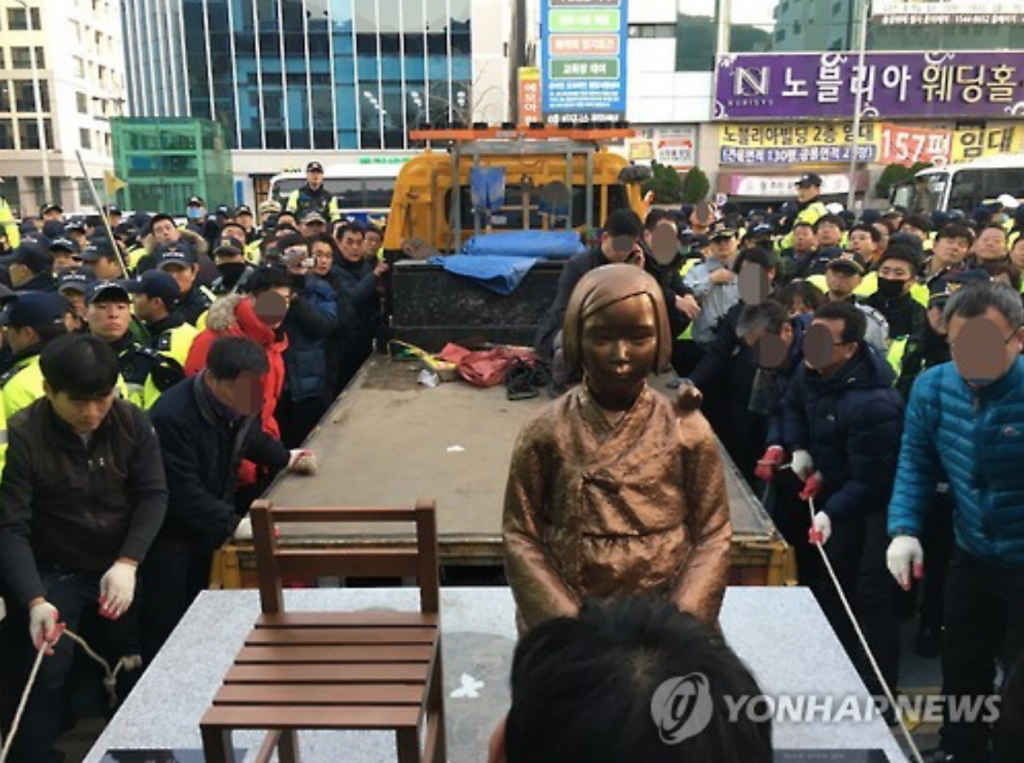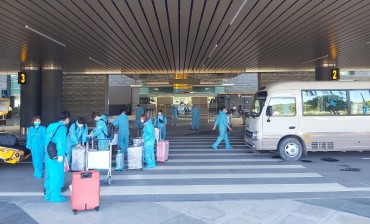
The district office was swamped with phone calls on Thursday and the district’s official website crashed on Thursday afternoon after being overwhelmed by visitors attempting to leave comments to denounce its “treacherous behavior”. (image: Yonhap)
BUSAN, Dec. 30 (Korea Bizwire) – On Wednesday, a civic organization tried to erect a statue representing comfort women – Korean sex slave victims of the Japanese military during the Second World War – in front of the Japanese consulate in Busan.
The attempt failed when Dong District officials and the police intervened, and forcefully removed and confiscated the statue.
December 28 marked the first anniversary of the Korea-Japan deal last year, in which Tokyo apologized for its colonial-era atrocities and agreed to provide 1 billion yen (US$9.4 million) for the victims, which it euphemistically called comfort women.
The arrangement faced a barrage of criticism for the Japanese government’s ambiguous “apology” and the Korean administration’s hasty decision to accept the offer without thorough consideration or prior talks with the surviving victims.
Dong District officials faced angry phone calls and protests in front of the district office, crippling their daily operations following the removal of the statue, and the district has finally given in to the criticism, announcing early Friday that it will return the statue and authorize its installation.
The district office was swamped with phone calls on Thursday and the district’s official website crashed in the afternoon after being overwhelmed by visitors attempting to leave comments to denounce its “treacherous behavior”.
Many of the phone calls to the headquarters also condemned Wednesday’s action, asking why the installation of the statue was blocked, demanding that the confiscated statue be returned, and even questioning the nationality of the officials who took part in the process, said an unnamed official from the district office.
“We have so many phone calls coming in that we can’t focus on our normal work,” said the official.
Most of the district higher-ups in charge of the incident, including district chief Park Sam-seok, were impossible to reach on Thursday. In fact, Park didn’t even come to work on Thursday after taking leave to attend the national Saenuri Party committee meeting.
Meanwhile, certain public servants from the district expressed remorse and shame for having to participate in the removal of the statue.
An official wrote on an online bulletin for the public servants’ union saying, “I was there at the site. I’m sorry, I want to kill myself.” Another official also expressed regret, writing, “I feel ashamed of myself.”
The Busan branch of the Korean Government Employees’ Union paid a visit to the Dong District office to meet with one of the directors, demanding to know who ordered public servants to be mobilized for the procedure, saying, “as fellow public servants, we are extremely ashamed of the statue’s removal. It turned us into some agitators for the Japanese government.”
According to the district director, although some 140 district employees were gathered for the occasion, “they were all voluntary with no coercion.”
Following the widespread controversy, the district office announced Friday morning that it would allow the installation of the statue with district chief Park apologizing for the conflict.
“We will not stop the installation, nor ask the police to intervene,” he said.
The statue was built thanks to 85 million won ($70,803) in public donations. As for its installation in front of the Japanese embassy, the Ministry of Foreign Affairs had said on Tuesday that the decision was “up to the respective local government.”
By Joseph Shin (jss539@koreabizwire.com)






